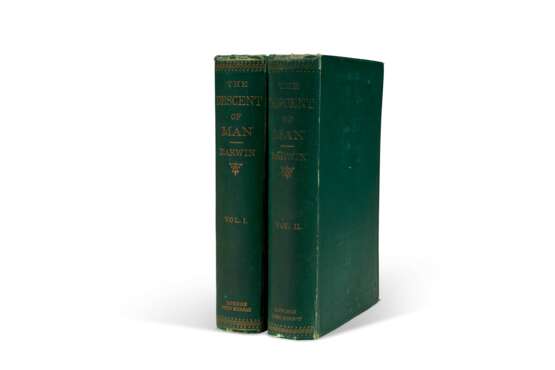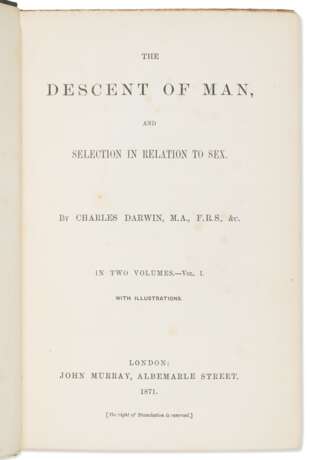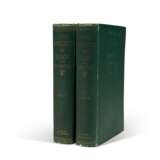ID 627526
Lot 36 | The Descent of Man
Estimate value
$ 4 000 – 7 000
First edition, first issue—the first appearance of the word "evolution" in any of Darwin's works. The copy of Charles Bree, a contemporary ideological opponent of Darwinism. A year after this book was published, Bree followed up with his second work refuting Darwin's findings: An Exposition of the Fallacies in the Hypothesis of Mr. Darwin, London, 1872.
Darwin's Descent of Man “caused a furor second only to that raised by the Origin” (Norman). It argues for the common origins of all mankind, placing humans in the evolutionary scheme Darwin had outlined for the rest of the animal kingdom in The Origin of Species. However, not all evolutionists shared this view—many, including Alfred Russel Wallace and Ernst Haeckel, argued for multiple origins of different human species. Science writer Richard Dawkins has noted that Darwin's supposition that the human species arose in Africa was “typically ahead of its time,” and despite the strong social pressures to think otherwise, “he carefully considered and decisively rejected the idea ... that different human races should be regarded as separate species.” Freeman 937 (vol. II Freeman's first issue); Garrison & Morton 170; Norman 599.
Two volumes, octavo (190 and 188 x 123 mm). Half-titles, numerous illustrations in text, 16 pp. ads at end of both vols dated January 1871 (light spotting at ends, to ads, and to fore-edges). Original green publisher's cloth, blind-stamped boards and gilt spine (hinges cracked, upper hinge of vol. 2 starting to separate, mild rubbing to tips, gilt-lettering a bit dulled on vol. 2); custom slipcase. Provenance: Dr. Charles Robert Bree (1811-1886, ornithologist; vol. 1 with bookplate and a few pencil emphasis marks).
| Artist: | William Shakespeare (1564 - 1616) |
|---|---|
| Applied technique: | Pencil |
| Artist: | William Shakespeare (1564 - 1616) |
|---|---|
| Applied technique: | Pencil |
| Address of auction |
CHRISTIE'S 8 King Street, St. James's SW1Y 6QT London United Kingdom | |
|---|---|---|
| Preview |
| |
| Phone | +44 (0)20 7839 9060 | |
| Buyer Premium | see on Website | |
| Conditions of purchase | Conditions of purchase |













